2013-11-28
Abstract
In this month's VBSpam test, all but one of the 19 full solutions tested achieved a VBSpam award and eight of them stepped things up a notch to earn a VBSpam+ award. Martijn Grooten has the details.
Copyright © 2013 Virus Bulletin
All malware is bad, but some malicious programs are worse than others. CryptoLocker, which has been making the headlines since the late summer, is particularly nasty.
It locks up all the important files on your computer using strong encryption and demands a ransom of hundreds of dollars in exchange for the private key that is required to break the encryption. No one has been able to find a weakness in the malware and, although most people keep offline back-ups these days, if you don’t, you either have to pay the ransom or forgo your data.
CryptoLocker spreads via spam.
Having spent half a decade looking at a great many spam filters, I tend to believe that we’re doing particularly well when it comes to fighting spam – and that spam isn’t the biggest problem with email [1]. The results of the VBSpam tests, which show that email security products tend to do a rather good job of preventing spam from reaching users’ inboxes, reaffirm that belief.
But it only takes one email to slip through the filter, and one user to be tricked into believing a message is genuine (or who simply clicks a link or opens an attachment by accident) for an organization to be exposed to a nasty malware infection.
This is why it is important that we run these tests – and why we will continue to make a distinction between products that block, say, 99.3% of spam and those that block 99.7% of spam.
In this test, all but one of the 19 full solutions we tested achieved a VBSpam award. No fewer than eight of these managed to avoid false positives completely, while keeping their catch rate above 99.5% – earning them each a VBSpam+ award.
The VBSpam test methodology can be found at http://www.virusbtn.com/vbspam/methodology/. As usual, emails were sent to the products in parallel and in real time, and products were given the option to block email pre-DATA – that is, based on the SMTP envelope and before the actual email was sent. Four products chose to make use of this option.
For those products running on our equipment, we use Dell PowerEdge machines. As different products have different hardware requirements – not to mention those running on their own hardware, or those running in the cloud – there is little point comparing the memory, processing power or hardware the products were provided with; we followed the developers’ requirements and note that the amount of email we receive is representative of that received by a smaller organization.
To compare the products, we calculate a ‘final score’, which is defined as the spam catch (SC) rate minus five times the false positive (FP) rate. Products earn VBSpam certification if this value is at least 98:
SC - (5 x FP) ≥ 98
Meanwhile, those products that combine a spam catch rate of 99.50% or higher with a lack of false positives earn a VBSpam+ award.
The test ran for 16 days, from 12am on Saturday 19 October to 12am on Monday 4 November.
Some technical issues on our side led to there being two gaps in the final corpus. The first of these, on 25 October, was caused by a failed sending daemon. Once this had been discovered, it was decided that the emails that had been waiting in the queue for hours should be excluded from the test. Four days later, a programming error led to the loss of several hours’ worth of emails that had been sent through the participating products.
Neither of these issues affected the remainder of the emails, nor did they affect any of the participating products. We thus ended up with a corpus of 94,675 emails, 81,313 of which were spam. 71,479 of the spam emails were provided by Project Honey Pot, with the remaining 9,834 emails provided by spamfeed.me, a product from Abusix. They were all relayed in real time, as were the 13,016 legitimate emails (‘ham’) and 346 newsletters.
As always, new sources were added for the latter two kinds of email, thus creating a broader corpus of legitimate messages.
As in the last test, those emails in the spam corpus that were marked as legitimate by at least half the products and did not appear to be real spam were excluded from the corpus. This meant that products that made the most natural decision on, say, Facebook invites, wouldn’t be penalized for doing so.
Figure 1 shows the catch rate of all full solutions throughout the test. To avoid the average being skewed by poorly performing products, the highest and lowest catch rates have been excluded for each hour.
Compared with a similar graph plotted in the last test, there isn’t a significant difference – the downwards spike that can be seen on 29 October was caused by the fact that during this hour relatively few emails were sent, thus giving a single email a lot of weight towards the average.
Of the 81,313 spam emails in the corpus, 78,575 were blocked by all participating full solutions. That is 96.6 per cent of the spam emails. We acknowledge that a disproportionate number of spam emails used in the VBSpam tests are those that are easier to block (and as such, the percentages given in this test should always be considered in the context of the test) – nevertheless, this is an impressive statistic.
When you also consider the fact that there are very few electronic mailboxes that aren’t protected by any kind of anti-virus software, it suggests that stories about spam emails sent out in the millions may be missing the point somewhat – most of the emails get blocked anyway. What matters is: what are the emails that are being missed?
The ‘winner’ in that respect in this test was a French 419 scam. Only four of the 19 participating full solutions blocked this email, despite the fact that a sob story, combined with an offer of a percentage of a large sum of money, is an obvious and well-known form of spam:
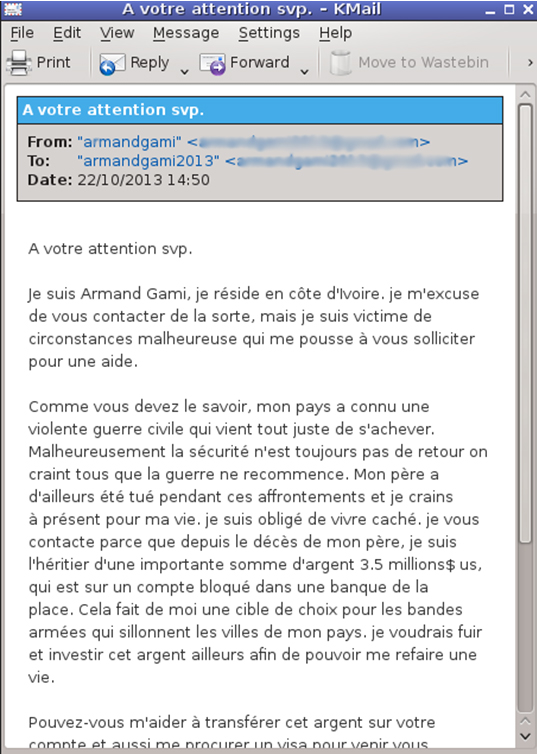
Two further instances of this email were sent the next day, when only one more product blocked them. 419 scams, particularly those in non-English languages, tend to be difficult to block.
More worryingly, there were a number of phishing emails that were missed by at least half the products. It only takes one employee to believe that their mailbox is indeed ‘over its size limit’ and to click on the ‘verification’ link for an ‘upgrade’ for an entire organization to be compromised:
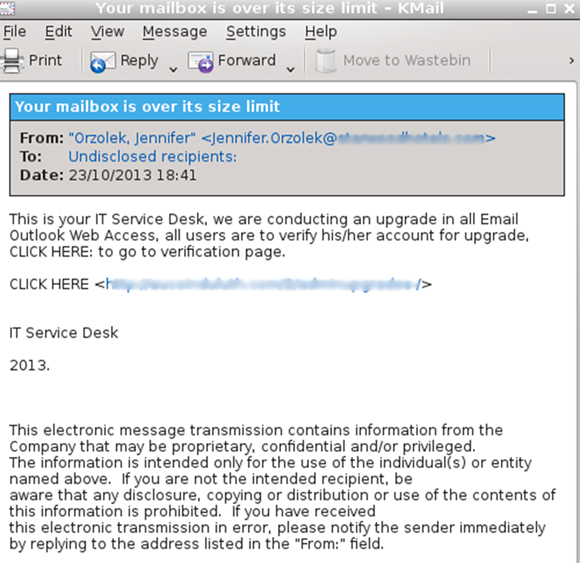
Perhaps most surprising were three emails that were missed by eight or nine participants – the subject line of which had helpfully been tagged (presumably by an outbound spam filter) with the words ‘suspected spam’.
On a more positive note, none of the 100 ‘most difficult’ emails in the corpus (determined by the number of products that failed to block them) contained a malicious attachment. Although this test doesn’t look at the blocking of malicious attachments in itself, it was pleasing to see that this kind of spam, which has seen a resurgence in recent years, is not reaching users’ inboxes in very large numbers.
SC rate: 99.48%
FP rate: 0.15%
Final score: 98.71
Project Honey Pot SC rate: 99.49%
Abusix SC rate: 99.37%
Newsletters FP rate: 6.4%
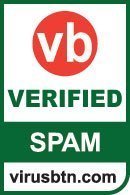
Axway, a global company headquartered in Phoenix, Arizona, calls itself ‘a market leader in governing the flow of data’. Email is one of these data flows, and it certainly needs to be ‘governed’ – for which purpose Axway provides the MailGate product. MailGate comes as a hardware appliance and a virtual appliance; we tested the latter.
Installation and set-up of the product was a smooth process. Once set up, the product can be managed using a web interface, which was comfortable to work with. It provides a lot of information on the status of both the mail stream and the product itself, and gives plenty of opportunity to fine tune the product.
Other than customizing it for our environment, we used the product’s default settings. Using these, MailGate missed just over one in 200 spam emails – mostly written in non-Latin character sets. The false positive rate was relatively high, but that can probably be attributed to the fact that this was Axway’s first VBSpam test. In any case, Axway earns a VBSpam award on its debut.
SC rate: 99.96%
FP rate: 0.00%
Final score: 99.96
Project Honey Pot SC rate: 99.97%
Abusix SC rate: 99.94%
Newsletters FP rate: 0.3%
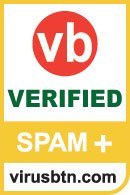
Just 29 spam emails were missed by Bitdefender in this test, thus increasing its spam catch rate to an impressive 99.96%. Once again, the solution correctly identified all of the legitimate emails, which means that it earns a VBSpam+ award, in doing so completing an unbroken string of VBSpam+ awards in 2013. It also remains the only product never to have missed either a VBSpam test or a VBSpam award.
SC rate: 99.52%
FP rate: 0.00%
Final score: 99.52
Project Honey Pot SC rate: 99.60%
Abusix SC rate: 98.98%
Newsletters FP rate: 2.6%

ESET’s Mail Security product narrowly missed out on a VBSpam+ award in the last test. On this occasion, there was a drop in the product’s spam catch rate (we couldn’t spot a clear trend among the almost 400 emails that were missed), but since it remained (just) above 99.5%, and there were no false positives, we were pleased to be able to give ESET its fourth VBSpam+ award.
SC rate: 99.87%
FP rate: 0.01%
Final score: 99.83
Project Honey Pot SC rate: 99.88%
Abusix SC rate: 99.84%
Newsletters FP rate: 0.9%

419 scams, lottery spam and the kind of spam whose subject lines are not to be repeated in polite company were among the 102 emails Fortinet’s FortiMail appliance failed to block in its 27th VBSpam test. This was a small improvement compared with its score in the last test and, with a single false positive and the fifth highest final score, Fortinet achieves its 27th VBSpam award.
SC rate: 99.55%
FP rate: 0.00%
Final score: 99.55
Project Honey Pot SC rate: 99.61%
Abusix SC rate: 99.18%
Newsletters FP rate: 2.3%

Blocking spam is easy; blocking spam while not blocking legitimate mail is hard. In this test, GFI MailEssentials demonstrates how this works in practice: compared to the previous test, the Windows solution had a lower spam catch rate, but it didn’t miss a single legitimate email (it missed four in the last test). As a consequence, the product’s final score remained almost the same, but this time we were able to give GFI a well deserved VBSpam+ award.
SC rate: 99.62%
FP rate: 0.05%
Final score: 99.39
Project Honey Pot SC rate: 99.72%
Abusix SC rate: 98.92%
Newsletters FP rate: 1.5%

As per our request, Halon Security’s virtual machine was reinstalled on a new server prior to this test. Until that point, its developers told me, they hadn’t touched their product since March 2011, when it was installed less than two days before its first participation in our tests. While our tests focus on performance rather than ease of maintenance, this is certainly something that speaks for the product, as was the fact that the reinstallation went as smoothly as the initial installation.
There was also good news on the performance side: Halon halved its false positive rate, while at the same time significantly increasing its spam catch rate. It thus continues its unbroken string of VBSpam awards with its 17th award.
SC rate: 99.45%
FP rate: 0.12%
Final score: 98.84
Project Honey Pot SC rate: 99.38%
Abusix SC rate: 99.96%
Newsletters FP rate: 3.2%

While most products saw a small decrease in their catch rates, IBM saw a nice improvement. Against that, however, stood 16 false positives – all but three of which were emails written in English. It is always a shame to see products block legitimate emails, but there is no product that never does so. Hopefully IBM will be able to reduce its false positive rates in future tests – for now it completes its first dozen VBSpam awards with relative ease.
SC rate: 99.92%
FP rate: 0.00%
Final score: 99.92
Project Honey Pot SC rate: 99.91%
Abusix SC rate: 99.98%
Newsletters FP rate: 0.3%

Despite missing 18 emails from the same spam campaign, Kaspersky’s Linux Mail Security product completed the test with a spam catch rate of 99.92% – even higher than its score in the last test. What is more, there were no false positives and just a single blocked newsletter, which means that Kaspersky finishes this test with the third highest final score, and its third VBSpam+ award.
SC rate: 99.95%
FP rate: 0.00%
Final score: 99.95
Project Honey Pot SC rate: 99.96%
Abusix SC rate: 99.93%
SC rate pre-DATA: 88.00%
Newsletters FP rate: 3.5%

The devil is in the details when it comes to spam filtering. Libra Esva is doing rather well when it comes to those details. It missed fewer than 40 spam emails – fewer than all but two other products and fewer than it did in the previous test in which it did so well. There was no compromise on the false positive score, as once again there weren’t any. This gave the product the second highest final score, and for the third time in a row, Libra Esva earns a VBSpam+ award.
SC rate: 99.53%
FP rate: 0.11%
Final score: 98.99
Project Honey Pot SC rate: 99.58%
Abusix SC rate: 99.22%
Newsletters FP rate: 0.9%

Among the close to 400 spam messages missed by McAfee’s Email Gateway appliance were emails in foreign character sets, but also a number of emails offering ‘great job opportunities’ while actually recruiting for money mules. This is just one of many examples of types of spam email that are more than just a nuisance – falling for their scams could have serious consequences.
Thankfully, McAfee Email Gateway actually blocked more than 99.5% of emails – about the same percentage as it did in the last test. Its false positive rate increased, which dented the final score to just below 99, but the product easily earns another VBSpam award.
SC rate: 99.14%
FP rate: 0.02%
Final score: 99.02
Project Honey Pot SC rate: 99.84%
Abusix SC rate: 94.08%
Newsletters FP rate: 3.2%

With a spam catch rate of 99.14%, McAfee’s SaaS solution missed more spam than any other full solution in this test. We should point out that 99.14% is still a very decent score, and one that will keep many a customer happy, but it was a serious drop compared to the previous test (hopefully it was just a one-off glitch). On a more positive note, the product only blocked three legitimate emails (and saw a greatly reduced false positive rate on the newsletter corpus). It thus retained a final score of over 99, and achieved another VBSpam award.
SC rate: 99.61%
FP rate: 0.38%
Final score: 97.69
Project Honey Pot SC rate: 99.71%
Abusix SC rate: 98.87%
SC rate pre-DATA: 76.24%
Newsletters FP rate: 12.1%
Compared to a relatively poor performance in the July test, Net At Work’s NoSpamProxy saw a huge increase in its spam catch rate, which at 99.61% was rather good. Unfortunately, the product once again blocked a large number of legitimate emails – more than any other product. A lot of these were from a relatively small number of senders, and it is possible that the product has issues with certain kinds of email that are common in our legitimate mail streams. If that is the case, it shouldn’t be too difficult for its developers to tweak its settings and achieve a VBSpam award in future. This time, it missed the certification threshold by a small margin.
SC rate: 99.67%
FP rate: 0.00%
Final score: 99.67
Project Honey Pot SC rate: 99.73%
Abusix SC rate: 99.24%
SC rate pre-DATA: 87.90%
Newsletters FP rate: 4.1%

Netmail Secure has a long history of participating in the VBSpam tests, having participated in (and done impressively well in) the very first VBSpam test under the name Messaging Architects. Four and a half years later, spam has evolved in many ways but Netmail still offers a decent solution to protect against it.
The virtual appliance missed fewer than one in 300 emails in the spam corpus and did so without blocking a single legitimate email. It thus not only achieves another VBSpam award – it also earns its third VBSpam+ award.
SC rate: 100.00%
FP rate: 0.02%
Final score: 99.92
Project Honey Pot SC rate: 100.00%
Abusix SC rate: 100.00%
Newsletters FP rate: 3.2%

When told about the two false positives in this test, OnlyMyEmail’s developers said they had suffered a minor glitch on their side that would have been the likely cause. Indeed, the two emails were sent not long after each other, and when they were resent after the test, they were no longer blocked.
Not only were these the only two false positives, the product didn’t miss a single spam email throughout the full 16 days of the test. This is not the first time the product has pulled this off either, and it remains a fantastic achievement. Even with the ‘glitch’, the product finished the test with the third highest final score – and yet another VBSpam award.
SC rate: 99.67%
FP rate: 0.19%
Final score: 98.71
Project Honey Pot SC rate: 99.77%
Abusix SC rate: 98.93%
Newsletters FP rate: 15.9%

About 24 hours prior to the start of the test, on the request of Scrollout’s main developer, we installed a new version of the free and open source anti-spam gateway. This obviously had the desired effect, as the product’s false positive rate almost halved, while it maintained a high spam catch rate. Sure, there were more false positives than for all but one other product, but after failing to reach the required threshold in the last two tests, Scrollout earned a VBSpam award.
SC rate: 99.65%
FP rate: 0.05%
Final score: 99.42
Project Honey Pot SC rate: 99.63%
Abusix SC rate: 99.85%
Newsletters FP rate: 0.0%

As someone who often checks for offers in recently received mailings before going shopping, I know that many users don’t want legitimate newsletters to be blocked (these tests have shown that they regularly are blocked). I was thus pleased to see that Sophos’s Email Appliance did not block any of them – the only full solution in this test to achieve a zero false positive score in the newsletter corpus.
Unfortunately, the hardware appliance did block six legitimate (‘ham’) emails which, unlike the newsletters, count towards the final score. The final score was thus a little lower than in the last test, but at 99.42 it was still decent and Sophos easily achieves its 21st VBSpam award in as many tests.
SC rate: 99.75%
FP rate: 0.00%
Final score: 99.75
Project Honey Pot SC rate: 99.74%
Abusix SC rate: 99.86%
Newsletters FP rate: 1.5%

I was rather pleased to see SpamTitan reverse a slight downwards trend when it came to its spam catch rates. With a very impressive 99.75% of spam blocked, it did better than in any test since January. Even more pleasing was the fact that in this test, the virtual appliance didn’t block a single legitimate email and thus achieves its third VBSpam+ award – its first in a year.
SC rate: 99.63%
FP rate: 0.00%
Final score: 99.63
Project Honey Pot SC rate: 99.62%
Abusix SC rate: 99.69%
Newsletters FP rate: 0.3%

As a regular reader of the company’s blog, I know that Symantec does some good research into unwanted and dangerous emails, from the most targeted to the most mundane. It is nice to see this research paying off – the product has earned 23 VBSpam awards in a row, and it adds its 24th this month.
Moreover, with a spam catch rate that was a little higher than that in the September test, and no false positives, Symantec’s Messaging Gateway earns its third VBSpam+ award.
SC rate: 99.77%
FP rate: 0.05%
Final score: 99.54
Project Honey Pot SC rate: 99.82%
Abusix SC rate: 99.44%
Newsletters FP rate: 9.5%

Six false positives, four of which were in Russian and the other two in English, prevented ZEROSPAM from achieving another VBSpam+ award in this test. But with a spam catch rate of 99.77% (among the 185 spam emails the hosted solution did miss were fake job offers, dating spam and many emails in Chinese), ZEROSPAM earns its 11th VBSpam award.
SC rate: 90.93%
FP rate: 0.00%
Final score: 90.93
Project Honey Pot SC rate: 94.92%
Abusix SC rate: 61.95%
SC rate pre-DATA: 86.78%
Newsletters FP rate: 0.00%
Yet again, the combination of Spamhaus’s ZEN IP blacklists and DBL domain blacklists blocked more than 90 per cent of all emails. This shows that blocking by domain and IP address remains an effective way to stop a large chunk of spam. No wonder, then, that most participating products use a DNSBL of some kind. And using Spamhaus, as some do, is not a bad choice at all – especially since the product once again didn’t miss a single legitimate email.
SC rate: 21.33%
FP rate: 0.0%
Final score: 21.33
Project Honey Pot SC rate: 20.17%
Abusix SC rate: 29.76%
Newsletters FP rate: 0.00%
The spam catch rates of SURBL’s domain-based blacklist have been going up and down this year, a volatility that can be explained by a large variation in the spam that is sent. In this test they went down a little over 21 per cent – lower than it had been since SURBL joined the test, though as mentioned before, this may well be because spammers are getting better at using URLs that can’t be blocked.
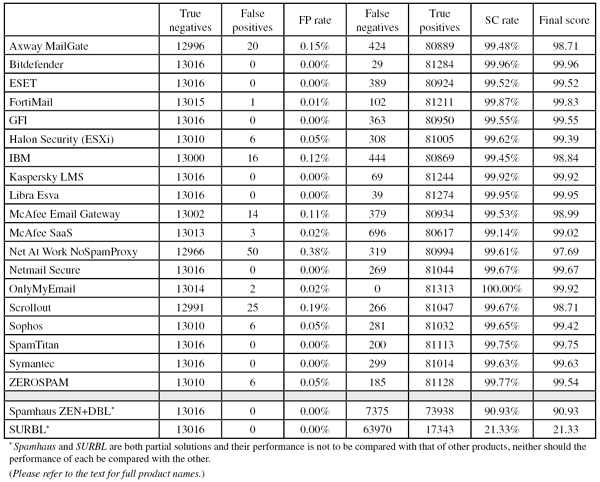
(Click here for a larger version of the table)
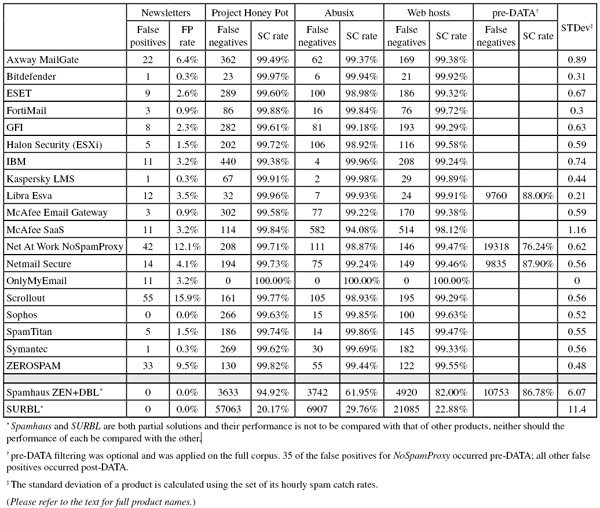
(Click here for a larger version of the table)
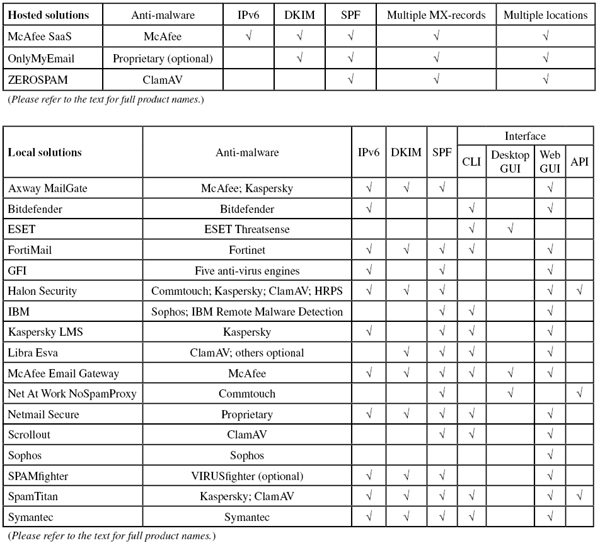
(Click here for a larger version of the table)
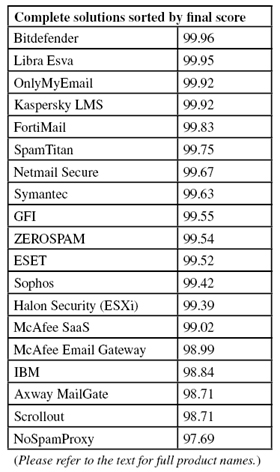
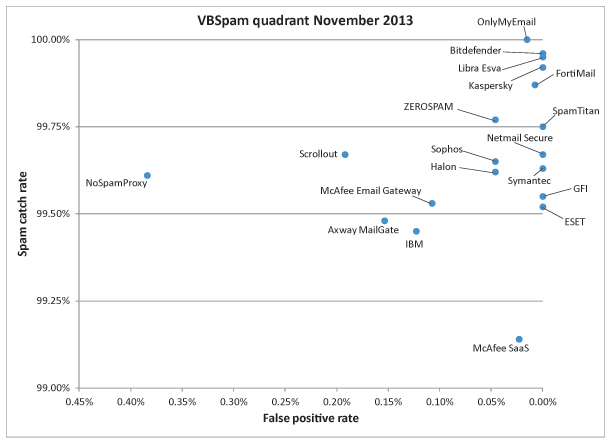
(Click here for a larger version of the chart)
With eight VBSpam+ awards granted, this was certainly a good VBSpam test. Nevertheless, there will be some product developers who won’t be so happy with the results.
There are many good email security solutions on offer, and some of them perform exceptionally well. At the same time, the spam problem hasn’t yet been solved and dangerous emails continue to slip through many a maze.
The next VBSpam test will run in December 2013, with the results scheduled for publication in January 2014. Developers interested in submitting products should email [email protected].